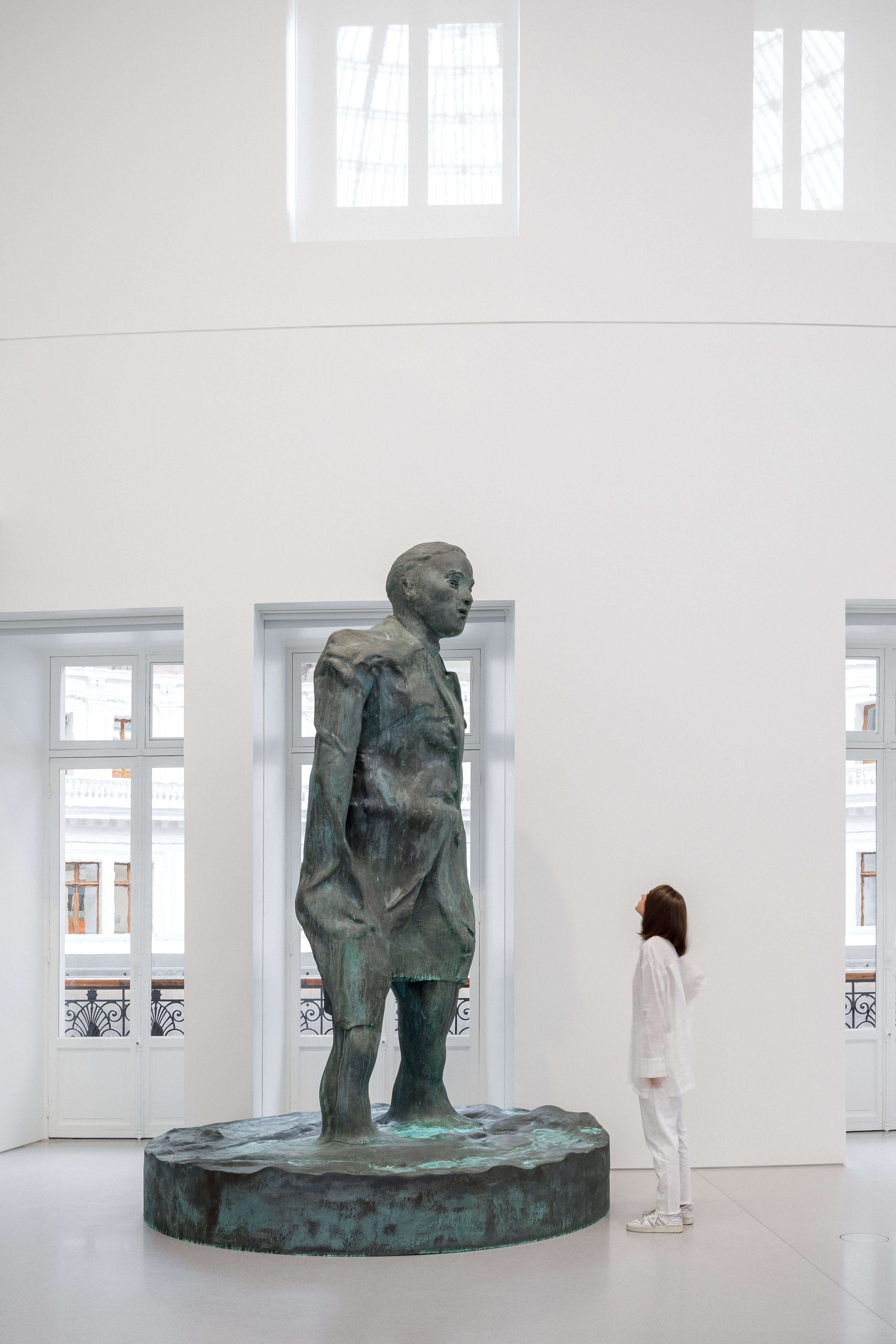Kippenberger / Krewer / Schütte

The confrontation of these three artists from different generations: iconoclast Martin Kippenberger, Thomas Schütte, the reinventor of contemporary sculpture, and young painter Florian Krewer, recounts the history of the contemporary German scene.
Martin Kippenberger
In Gallery 5, three large self-portraits by Martin Kippenberger are presented for the first time. Bitte nicht nach Hause Schicken (1983) shows the artist with a sign around his neck: “Please do not send me home”. Symbolizing wandering, the artist, as an outcast of a codified world, carries the memory of the victims of the tragedies of Deportation and extermination during the Second World War. With the series “Dear Painter, paint for me” (“Lieber maler, male mir” 1983), commissioned from poster artist Werner, Kippenberger had paintings and self-portraits produced that were not painted by him. His use of the poster was an implicit criticism of the status of an artwork: its value, uniqueness, signature, etc. Untitled (1992) is part of the “Hand-Painted Pictures” series, the painter’s second cycle of self-portraits. Here, the artist is shown half-naked, his stomach squeezed into purple shorts. He represents himself with outstretched hands, one palm open to the viewer, the other in a predatory gesture. The ensemble also features the monumental trompe l’oeil, Paris Bar, as well as twenty-one portraits on canvas, parodying a range of subjects and styles from the history of painting.
Born in 1953 into a Protestant family in Germany, Martin Kippenberger died in Vienna in 1997. A painter, he preferred the term “sales rep” to “artist”, believing it to be more appropriate to the art market, in which he actively participated. In this self-appointed role, Kippenberger brilliantly managed his persona by means of caricature and burlesque. He gave his works striking titles: “the unemployed man can relax on Saturday”, and so on. Drawing inspiration from popular culture and art history, he questioned the “death of painting” and the “avant-gardes”. Provocative, and at times cynical, his attitude was alternately irreverent and complacent, slating “beautiful” painting yet demonstrating great skill, fostering controversy and praise in equal measure.
Florian Krewer
The six canvases presented as two triptychs installed in the centre of Gallery 5 are either covered in a blood red or plunged into an intense darkness. If the power of painting is to personify, Florian Krewer touches on its mystery: his entire canvases are awash in flesh and raw colours, against the backdrop of a dark night, like the monster that shows its fangs in heat (2019), ready to pounce. In Krewer’s urban scenes, showing fights and “battles”, the bully, the accomplice and the victim seem to merge.
Florian Krewer was born in 1986 and currently lives in New York. He graduated in architecture but went on to study painting at the Kunstakademie in Düsseldorf from 2011 to 2017, where his teacher was renowned painter Peter Doig. His paintings take root from personal or found photographs, cut out and assembled in his preparatory sketches from which his compositions are born. His large-format canvases depict figures with indeterminate features, whose youth is revealed by their streetwear style of clothing. In the nocturnal or twilight atmosphere of these urban scenes with their nebulous backgrounds, it is not easy to distinguish the brawl from the embrace, the dance from the pickup. His silhouettes run, stand their ground, lash out, hesitate. Violence is never far away. We can guess the context, although we are given no keys to interpret it.
Thomas Schütte
An impressive collection of works by Thomas Schütte, some of which are presented for the first time by the Pinault Collection, is exhibited in Gallery 5 in dialogue with paintings by Martin Kippenberger and Florian Krewer. In this airy, high-ceilinged space, twelve strikingly sculpted heads from the powerful series “Wichte” (2006) overhang the entire length of the gallery, glaring defiantly at the visitor, just like the imposing monumental statue Mann im Wind III (2018) closes off the gallery space.
Born in 1954 in Oldenburg, Germany, Thomas Schütte lives and works in Düsseldorf. A pupil of Gerhard Richter and Fritz Schwegler at the Kunstakademie Düsseldorf, he developed a very diverse artistic practice, influenced by the minimal and conceptual art movements of the 1970s, tackling seminal topics like power, memory, the role of art and its futility in the face of the existential questions that haunt the human condition.
Sculpture, architecture, poetic variations and self-portraits structure the work of the artist, considered today as one of the reinventers of sculpture. Schütte has an antiheroic approach to art and rejects Joseph Beuys’ theory of the artist as a guide, preferring instead to introduce doubt and question certainties: “My works have the purpose of introducing a crooked question mark into the world,” he says. His sculptures often take the form of architectural maquettes or theatrical sets, temporary and imperfect, which ironically evoke major political and historico-artistic issues. Today, the majority of Schütte’s production focuses on the analysis of social structures, their political organization and impact on the lives of individuals, in an effort to expose the fragility and instability of contemporary systems.